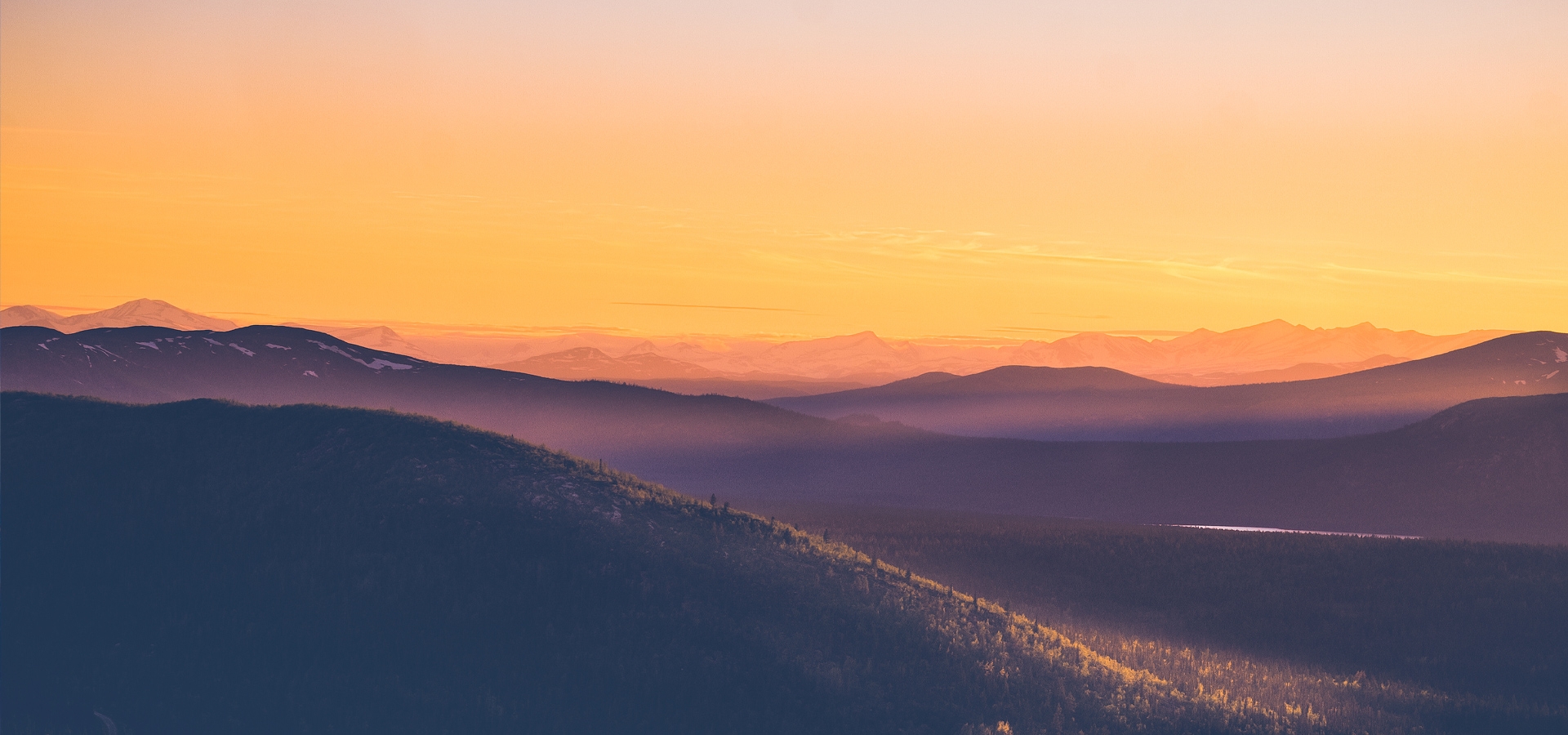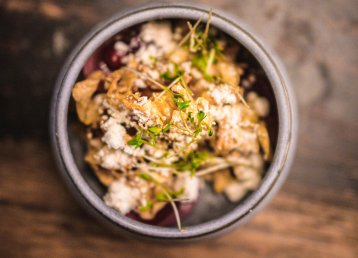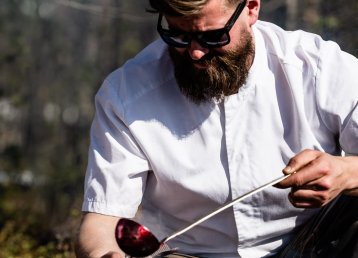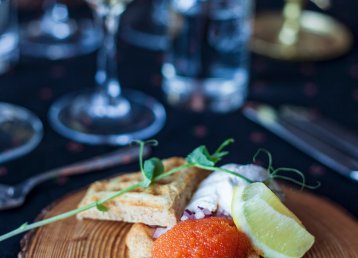In Swedish Lapland, we have a preference for honestly cooked food, a natural result of having a clean nature filled with excellent ingredients just around the corner. The Sámi began developing our cuisine thousands of year ago when pots simmered over campfires filled with what nature had to offer. Reindeer, of course. Elk, naturally. Birds such as ptarmigan and wood grouse, fish like grayling, salmon, trout, Arctic char and whitefish. During summer they were accompanied by berries and wild greens in the form of herbs, roots and other edible plants.
Many of our food traditions stem from the need to store and use ingredients all year round. By drying, smoking, salting and pickling the food supply was secured during the four seasons. The flavours you encounter on your plate today often have a history originating in a time when living near a food store was a luxury few people enjoyed. In a part of Sweden where the Sámi indigenous people still earn a living from the reindeer industry and stay in the mountains for long periods of time, this is a knowledge and craft that is very much alive. Try suovas, for example; it is a favourite on mountain hikes or archipelago adventures. Fry it in a muurikka pan with onions and mushrooms, then serve in a soft flatbread gáhkku.
Simple and honest, with the finest ingredients as main characters.
Free grazing, straight from nature
With pure natural grazing, meat from the wild becomes lean and healthy. Minerals and vitamins from the plant kingdom make the meat not only healthy but also tasty. It is as far from processed food as you can get. Elk, bear and deer roam freely in Swedish Lapland, in forests as well as in the archipelago. The elk-hunt is a near-sacred event for many in autumn, and just like ptarmigan hunting, it is an experience that involves nature, togetherness and tradition as well as making the most of our natural resources.
Reindeer also graze freely in nature, but unlike other game, they all belong to reindeer herders who identify them by the marking in the reindeer’s ear. In Swedish Lapland, there are 32 Sami herding communities, economic associations based on reindeer husbandry. Reindeer that belong to the forest Sámi communities graze all year round in the forest; the mountain Sámi reindeer graze in the mountains during summer and in the forest or by the coast in winter, where the grazing is more easily accessible that time of year.
From tail to nose
Using the entire reindeer is a Sámi tradition. Intestines and stomachs can be cleaned and used to make blood sausage and gurpi, reindeer mince that is first smoked, then cooked in an oven. Antlers and furs are used in the traditional handicraft, duodji, together with plant parts. In the past, reindeer were milked, and cheese made in shallow moulds, a tradition that still exists today. Sámi culture and traditional knowledge of animals and nature have developed reindeer husbandry into an industry that compares favourably in the competition for environmentally friendly and healthy food. This knowledge is as relevant now as it was back in the day, with conscious consumers demanding naturally produced food with no unnecessary additives.
Many of the ingredients from Swedish Lapland are also highly sought after in gourmet kitchens around the world thanks to their high quality. There is also a tasty local tradition of preserving traditional cooking methods and taking advantage of flavour combinations suggested by nature itself, such as the combination of game and berries.
Open landscapes and a coffee culture
Perhaps agriculture is not the first thing that comes to mind when you think about Sweden’s northernmost destination – after all, this is the Arctic. But the fact is that Swedish Lapland is largely self-sufficient when it comes to milk. In the Torne Valley, the conditions are also very favourable for growing vegetables, and the landscape here is very similar to southern parts of the country. The clean water in our rivers has created conditions suitable for agriculture in the river valleys of Vindelälven, Skellefteälven, Piteälven, Luleälven, Råneälven, Kalixälven and Torneälven. The cold winter climate also provides good conditions for environmentally-friendly agriculture, with less use of pesticides.
There is also a long tradition in the region of refining dairy products to extend their shelf life. The most distinctive product is the coffee cheese that originates in the Torne Valley. The cheese is made from unpasteurised milk and then baked. Traditionally, it is served as small cubes in coffee instead of milk. Another serving tip is to heat the cheese in the oven and serve as a dessert with cloudberries. The coffee you are offered during a snowmobile outing or a hike is boiled over an open fire. Far from the city’s pulse, making coffee is allowed to take time and be enjoyed in conversation while nature and a flaming fire set the mood.
Feel free to ask your guide how they prefer their coffee: with a pinch of salt to add minerals to the clear mountain water, or perhaps with a slice of dried reindeer heart.
Kaffetåren
Cheese and meat in the coffee? Oh yes! Johhny in Arjeplog will tell you all about it. You can also read the story. here.
A lively greeting from the ice sheet
Streams, rivers, lakes and seas have always been important lifelines for people in Swedish Lapland. 30,000 lakes, more than 300 km coastline and all four national rivers mean that fishing has always played a major role, both for nourishment and recreation. The Bothnian Bay contains the largest brackish water archipelago in the world, which means that any involuntary gulps of water will not taste very salty at all.
The inflow of fresh-water from the rivers is fresh and rich in minerals, creating unique conditions. This means that the vendace, which rarely grows larger than 20 cm, has a unique variety of food available. This, in turn, provides us with the world’s finest roe: Kalix vendace roe. The characteristic Kalix vendace roe is often served in festive contexts such as the Nobel dinner. It was the first food item in Sweden to be awarded a Protected Designation of Origin status to prove that the pure, excellent taste is unique. Other members of this exclusive group are, for example Champagne and Parma ham.
The best whitefish in the world
A much larger relative of the vendace travels upstream in the Torne River to spawn, which is when tradition calls for fishers to stand ready, equipped with long-handled hand nets. Throughout July, activity levels peak in the Kukkola rapids, among other places. Long bridges are built to allow fishers to reach and haul out the whitefish where it stops and rests in burrows along the bottom. The whitefish is then traditionally grilled over an open fire – it is a delicacy, served with new potatoes and melted butter.
If you hike in the mountains in Swedish Lapland, it is important to bring a mug, as you drink water straight from the streams and brooks. With water this clean, it is not difficult to understand why Arctic char, grayling and trout are happy as a fish in water here. Even in winter ice fishing attracts many, especially when the rays of the spring sun warm the landscape. Fishing arks are a common sight: tiny cabins out on the ice with a handy hole for fishing in the middle of the floor. Fishing in the region is as varied as the waters; you can learn how to make flies dance across the surface or relax with a fishing rod. Fishing is probably the closest we can get to meditation, and we do it with pleasure and often.
The whitefish in Kukkola
The freshest fish you can eat?
The wild green and all the other colours
After a long and snowy winter, there is even more joy when green buds begin to burst. In Swedish Lapland, nature literally explodes in the powerful spring sunlight. Before you know it, everything grows like crazy. The midnight sun helps speed up the process, and it charges berries with vitamin C and antioxidants. Apart from blueberries and lingonberries, we have other super berries like sea buckthorn in the archipelago and sweet Arctic bramble and juicy cloudberries in marshlands, forests and mountains. A northern variety of crowberries has male and female flowers on the same plant, making them extra rich in berries.
Not only animals enjoy this nutritious offer, but we also take the opportunity to bend our knees as soon as we get the chance, enjoying the goodies straight from the plant. We juice and jam as much as we can, the rest goes in the freezer.
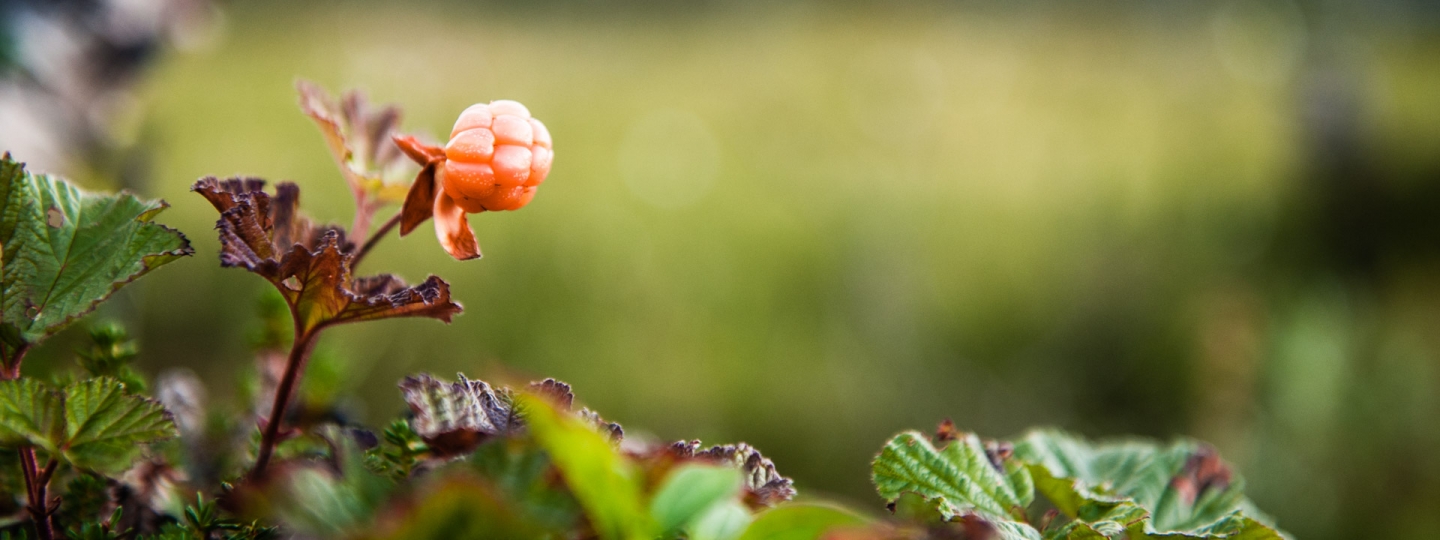
Cloudberry – or 'hjortron'
The cloudberry tastes as good in desserts as in main courses.
Nature’s pantry
Herbs and other green plants are also filled with useful minerals and vitamins. Angelica is a traditional wild-growing vegetable that the Sámi would pick once they had moved with their reindeer to the summer grazing area. The stem can be eaten grilled or fresh and is said to strengthen the immune system and help with stomach pain. You can make porridge from the root, and these days the stems are used to make jam or marmalade, and the seeds are dried as a spice. A Sámi tradition is to chop and boil herbs, then heat them with reindeer milk to make it thicken. This guompa could then be stored in a keg over winter. Juobmo, Alpine sorrel, was picked in bags in summer to provide a rich supplement of vitamin C in the Sámi diet. Just like leaf spinach it melts when heated and can be cooked as a soup, for example, or used in sauces.
Our rich pantry might be hidden under the snow, but rest assured – it is there, waiting for the spring sunshine.


























